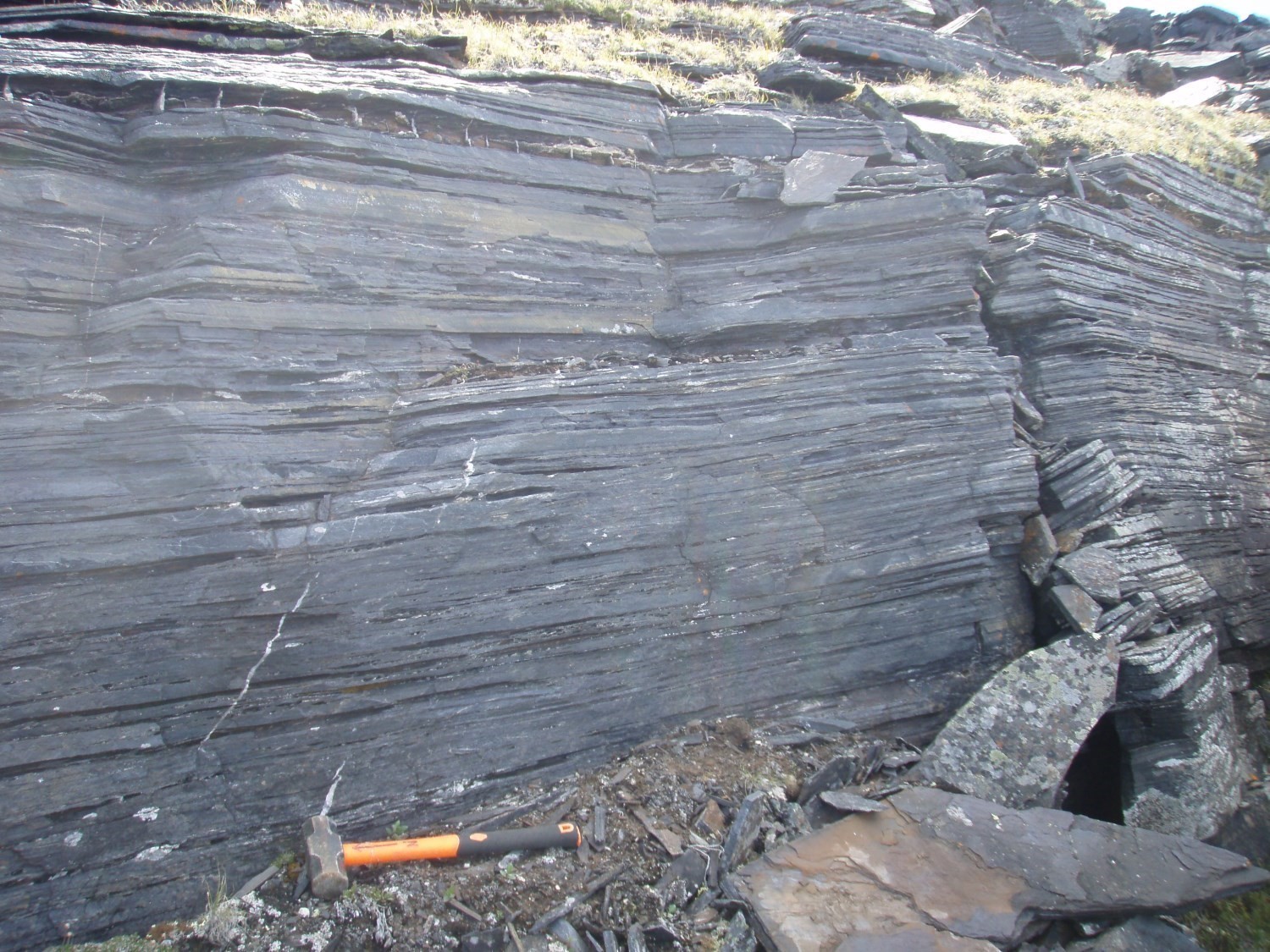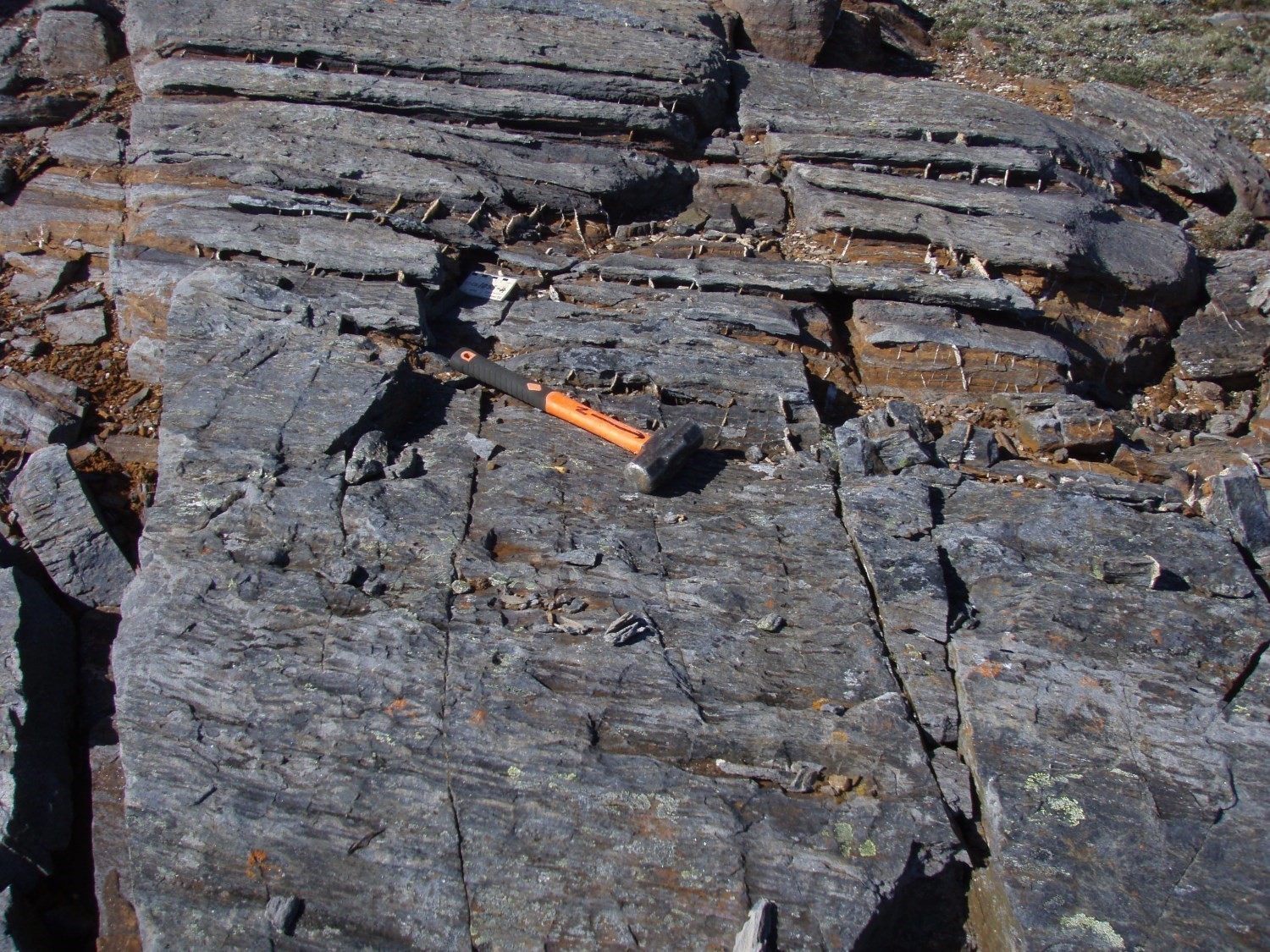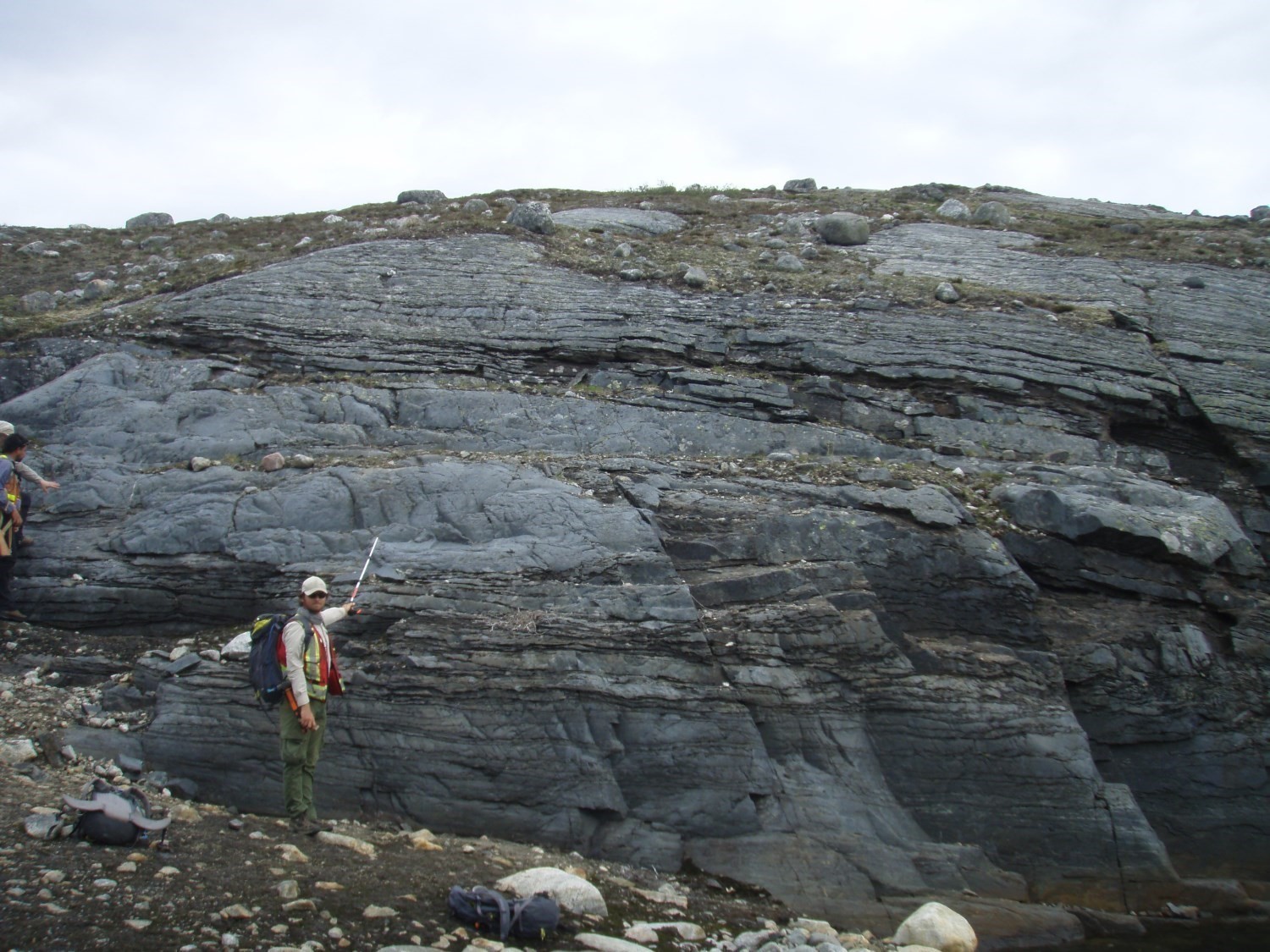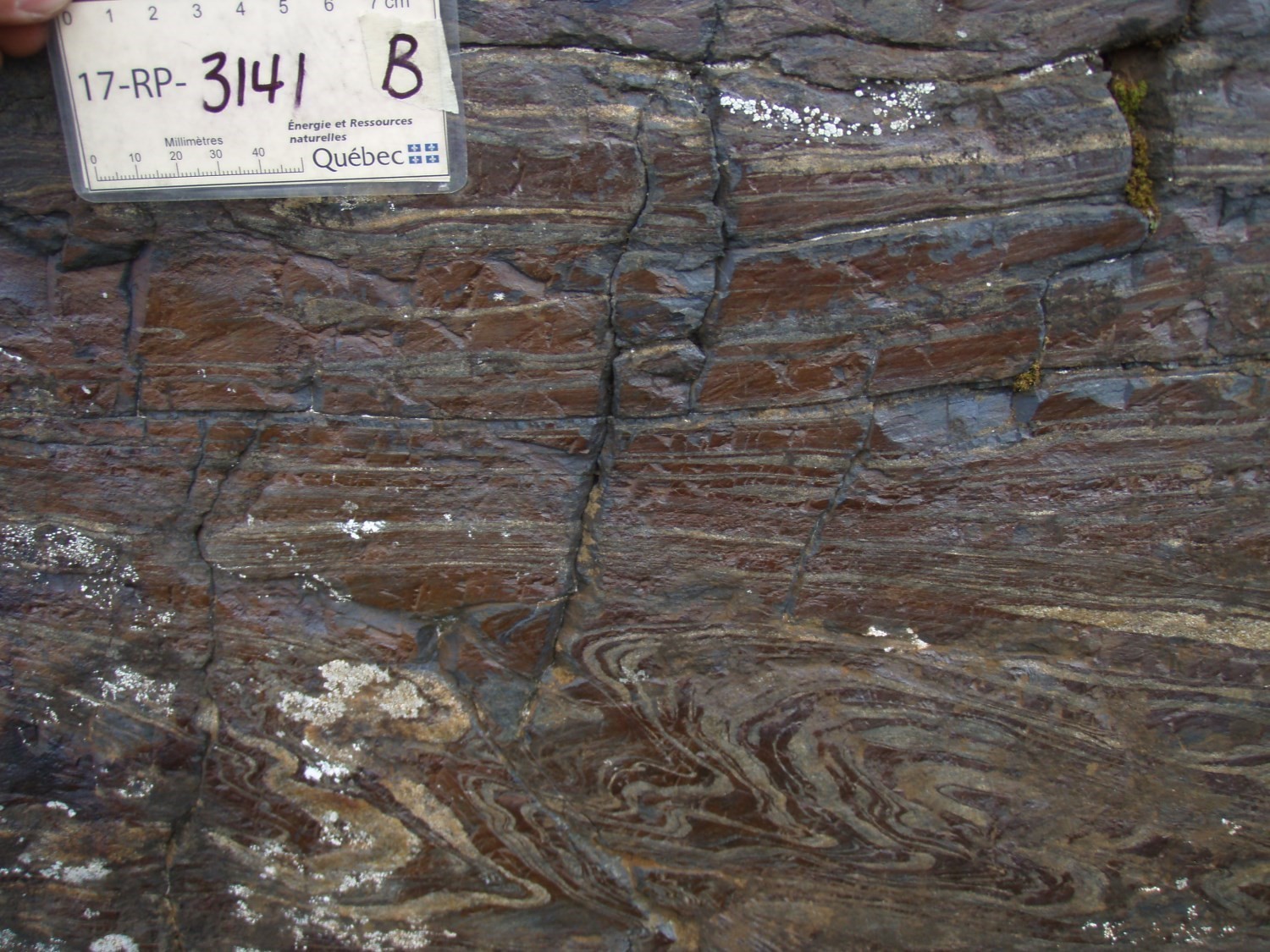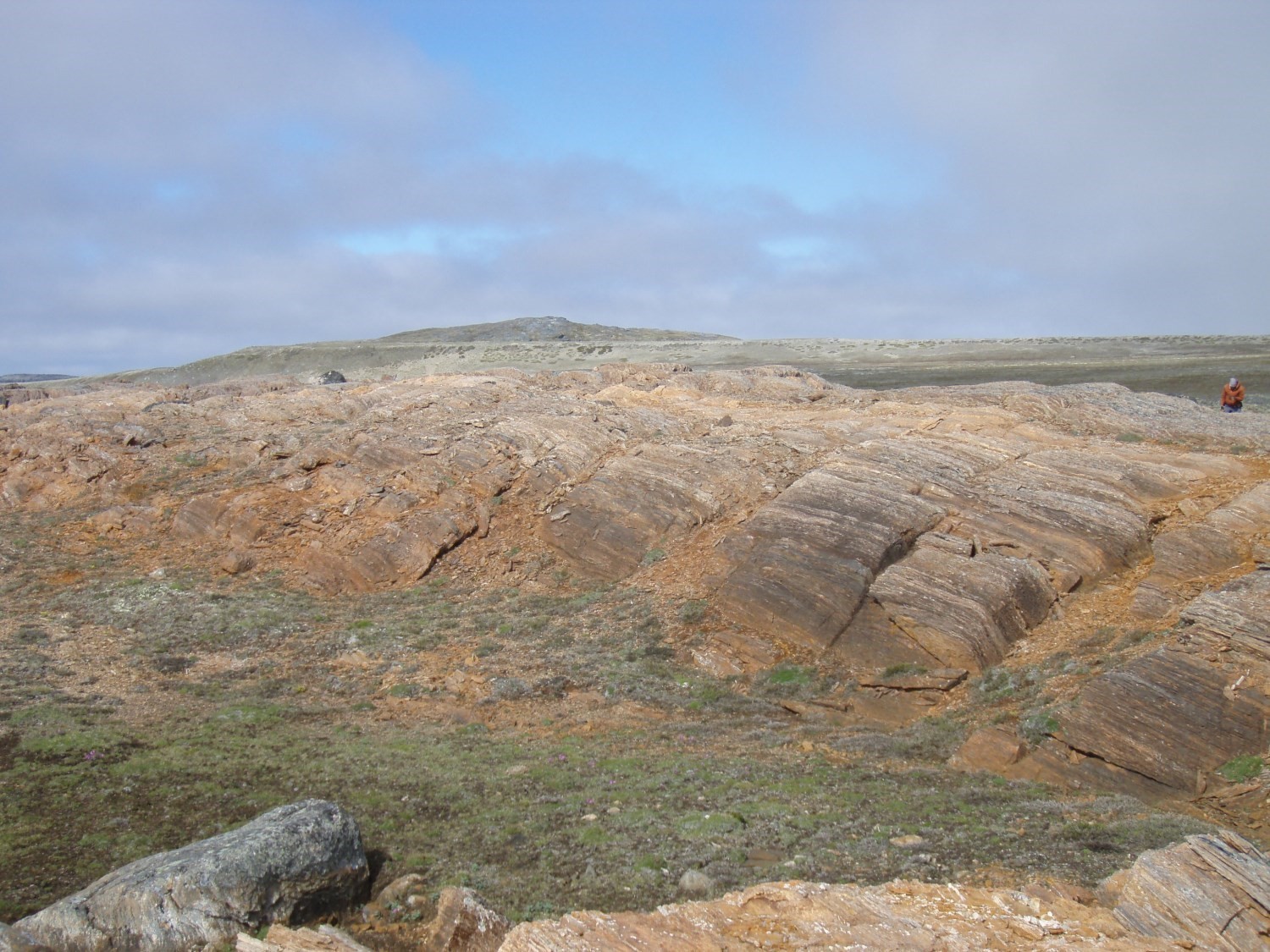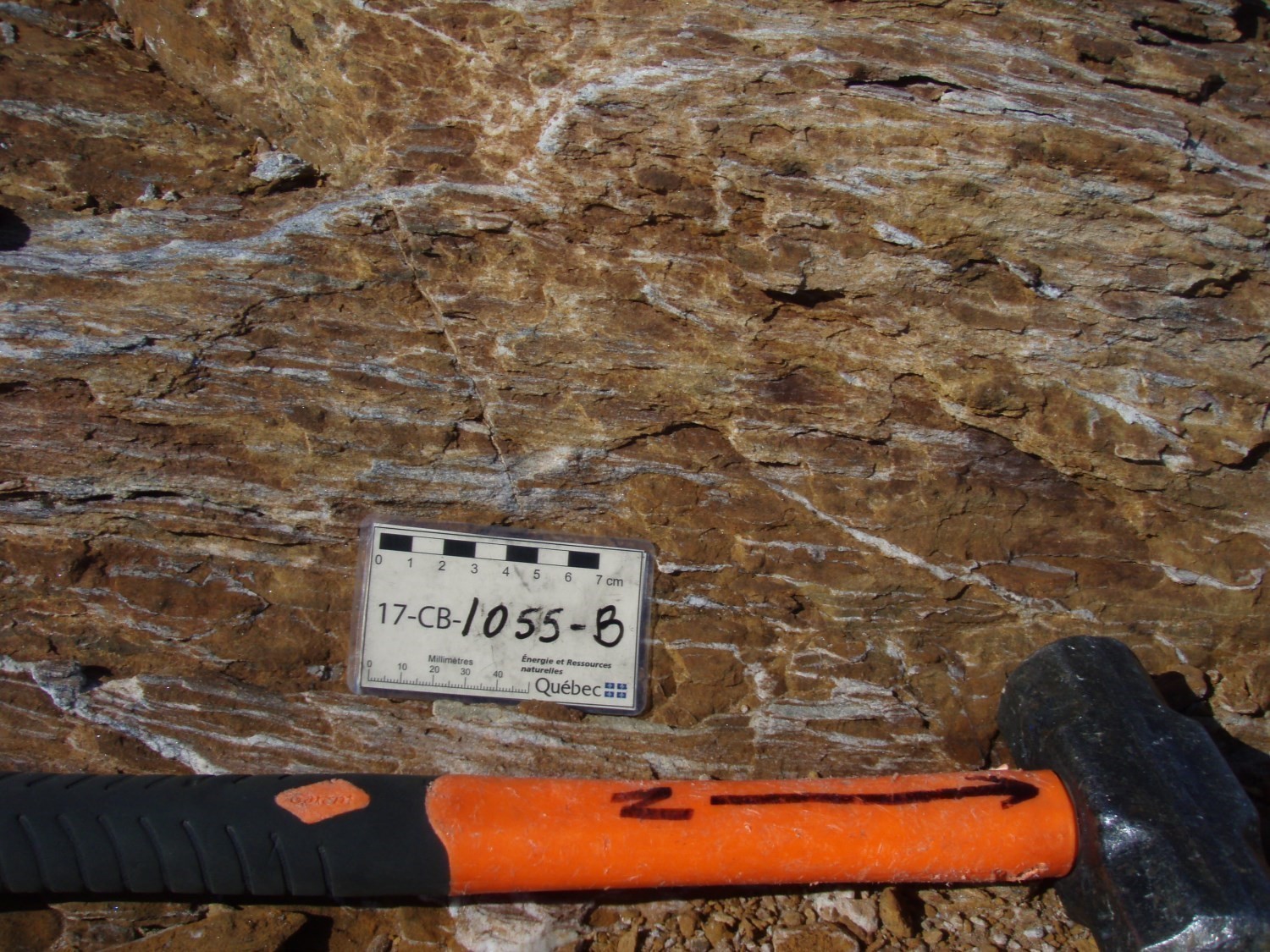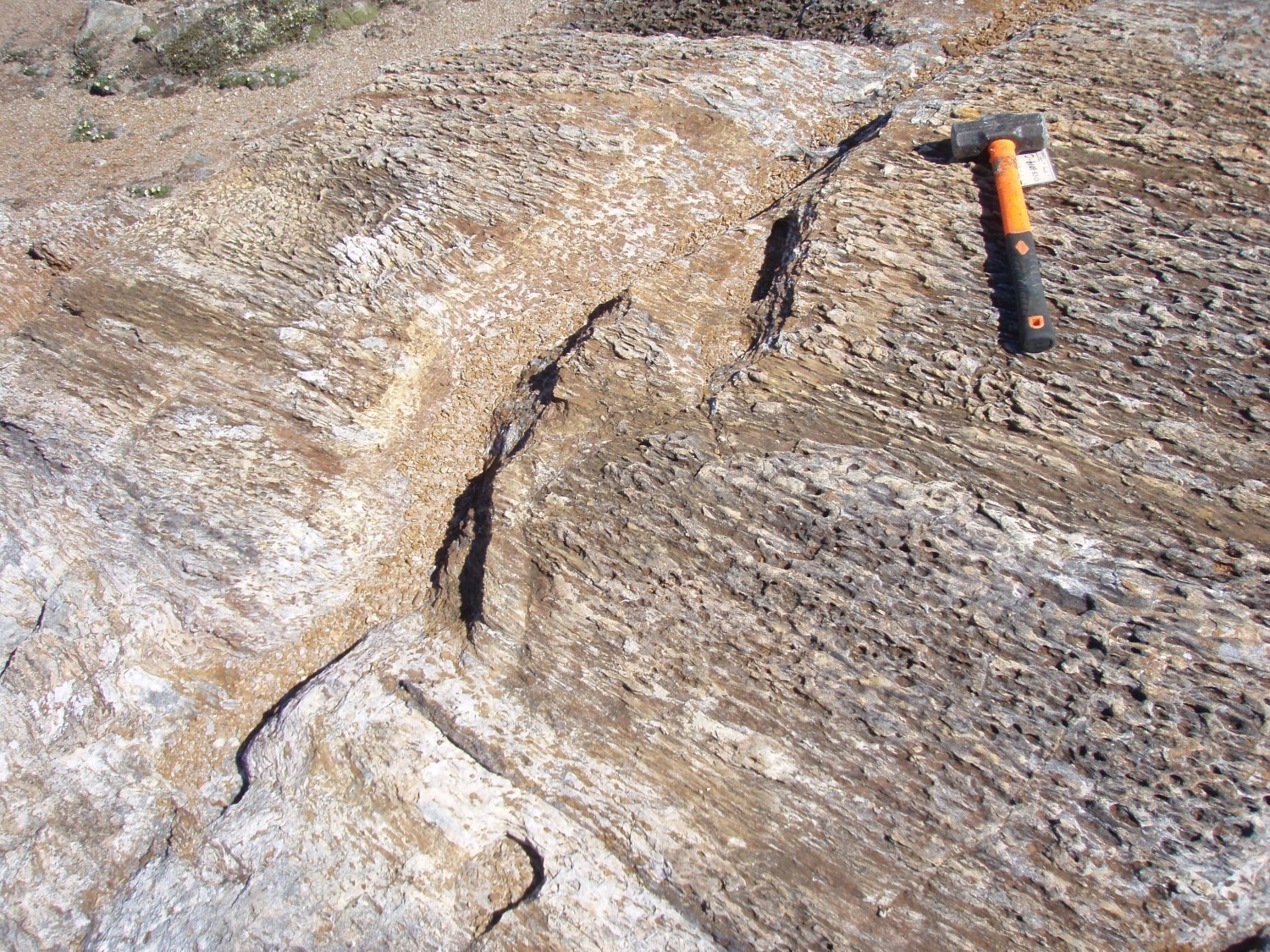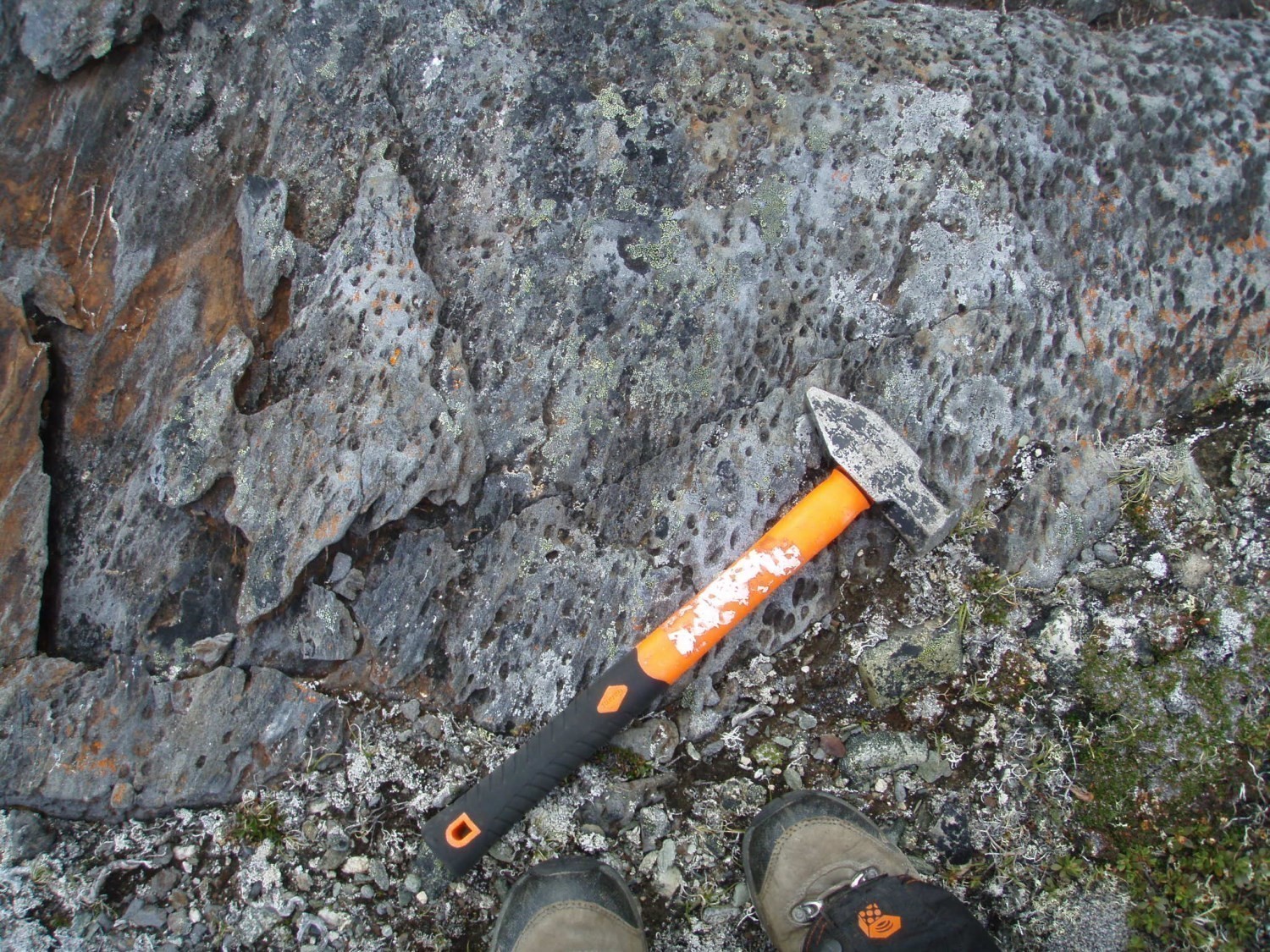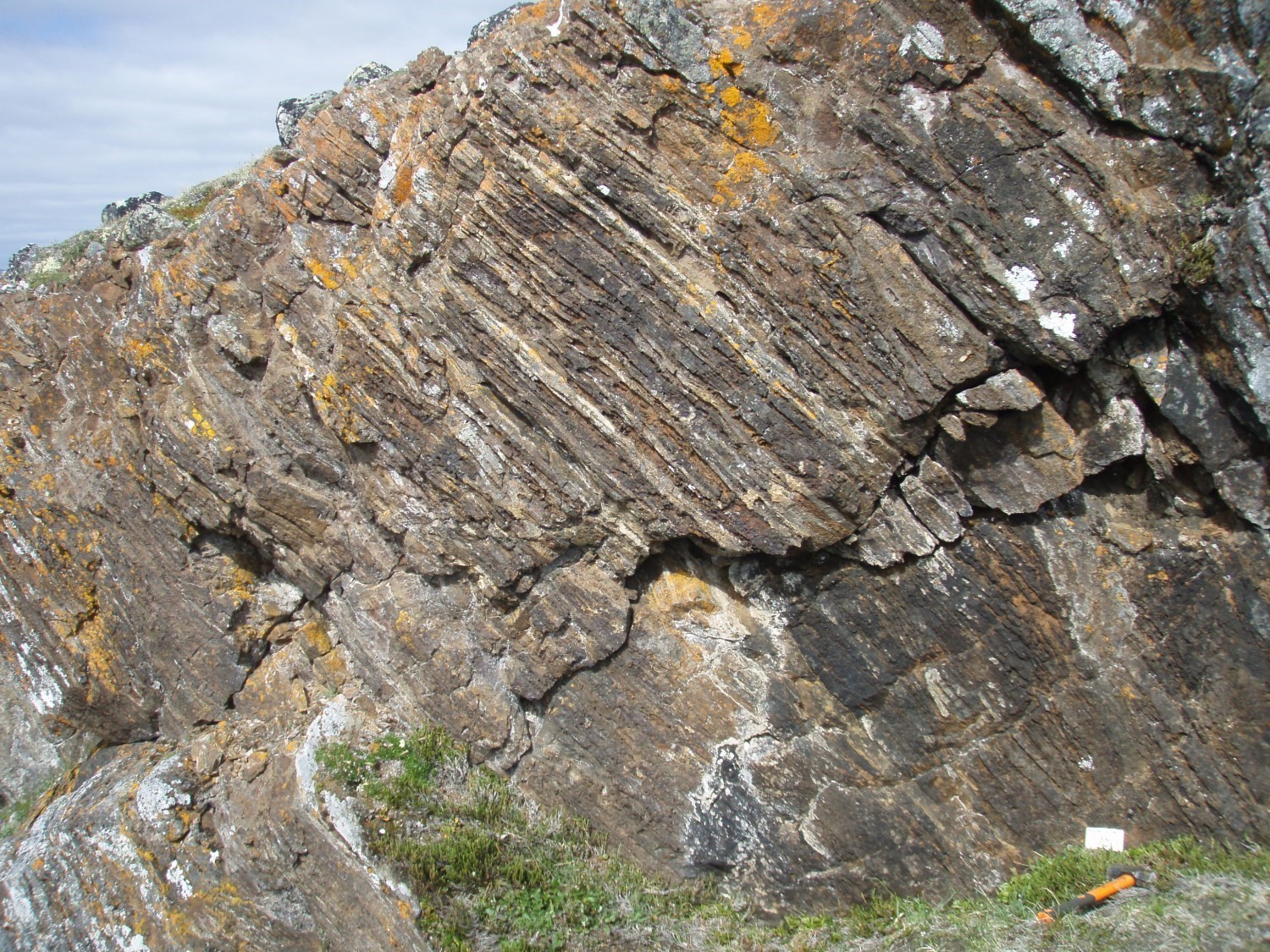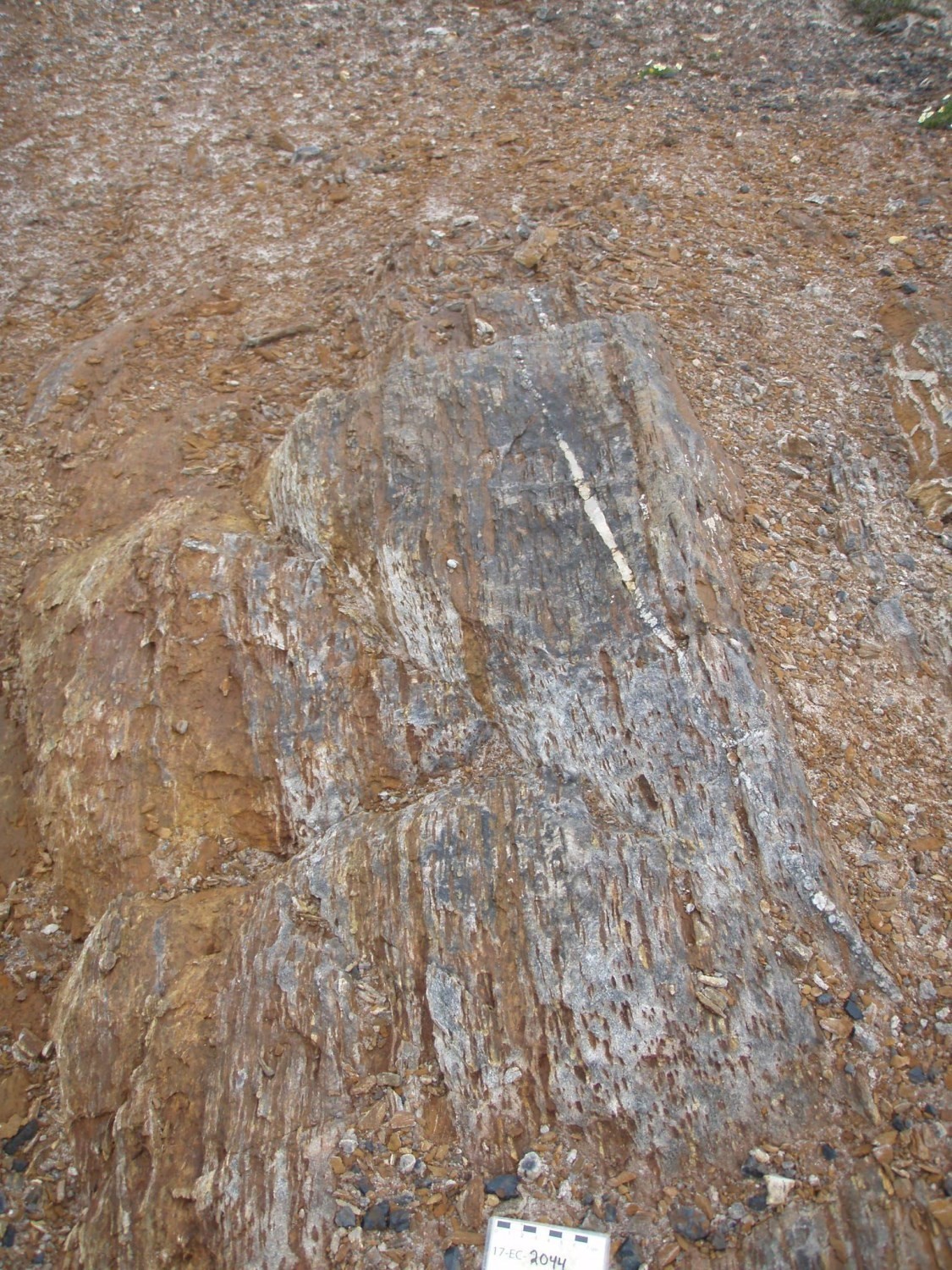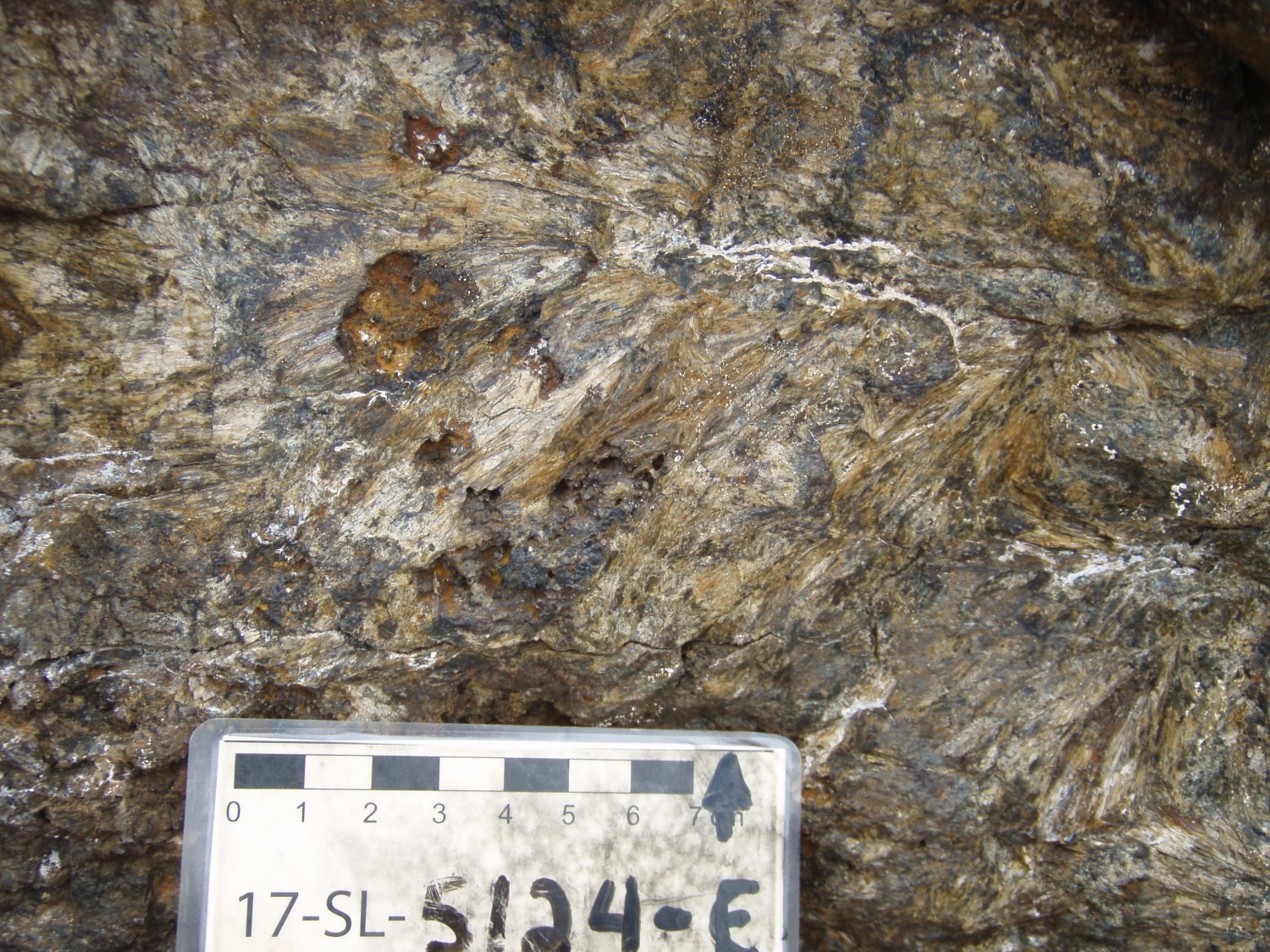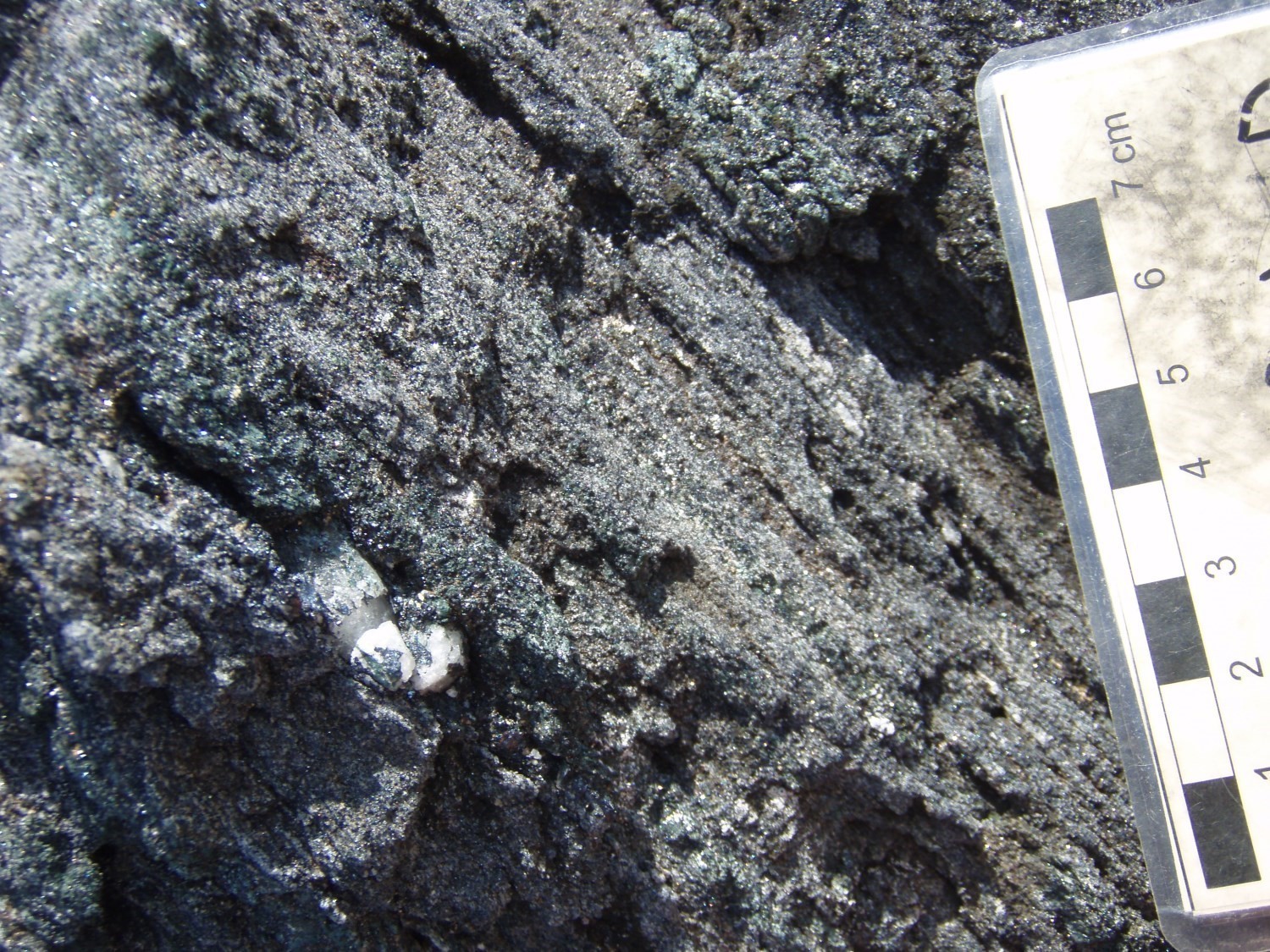
Last modified:
Translation of original French
pPso5 Silicate facies iron formation and micaceous schist
pPso4 Black chert
pPso3 Carbonate facies iron formation
pPso2 Silico-carbonate facies iron formation with carbonate porphyroblasts and chert
pPso1 Hematite or magnetite oxide facies iron formation, arenite and jaspe
| Author: | Frarey and Duffell, 1964 |
| Age: | Paleoproterozoic |
| Reference section: | There is no formal reference section for the formation; the area described by geologists from the Iron Ore Company of Canada, Harrison (1952) and Harrison et al. (1972) east of Schefferville can represent it (Dimroth, 1978). |
| Type area: | Area east of Schefferville (NTS sheet 23J15) described by geologists of the Iron Ore Company of Canada (Harrison, 1952; Harrison et al., 1972). |
| Geological province: | Churchill Province |
| Geological subdivision: | New Quebec Orogen (Labrador Trough) / Bérard, Cambrien, Hurst, Mélèzes, Payne, Schefferville and Tamarack lithotectonic zones |
| Lithology: | Iron formation, arenite, chert and jaspe |
| Type: | Lithostratigraphic |
| Rank: | Formation |
| Status: | Formal |
| Use: | Active |
Background
The term “Sokoman Iron Formation” was first introduced by geologists at the Labrador Mining and Exploration Company (1949, in Frarey and Duffell, 1964) to designate the main cherty ferriferous rock unit in the Schefferville area. The word “Sokoman” is not a geographical reference, but a Montagnais word meaning “iron” (Dimroth, 1978; Dressler, 1979). The term was redefined as Sokoman Formation and officially introduced by Harrison (1952). According to the North American Stratigraphic Code, the name of a unit should include a geographic element. The name Sokoman Formation remains in use, however, as it was introduced in publications prior to the application of the code in Canada (Dimroth, 1978). Zajac (1974) and Wardle and Bailey (1981) expanded the use of “Sokoman Formation” to include the Ruth Formation. These formations remained separate units for Dimroth (1978). The Sokoman Formation has been the subject of several studies mentioned in the work of Dimroth, 1978. This report notes that: « The stratigraphy of the Sokoman ferriferous rock has been extensively worked on, particularly around Schefferville. Stubbins et al. (1961), Gross (1968), Gross et al. (1972) and Zajac (1974) summarized the extensive work of the Iron Ore Company of Canada geologists. Perrault (1955), Bergeron (1954), Bérard (1967) and several mining companies (work summarized by Gross, 1968) have made significant contributions in areas further north.”
Further mapping was conducted in the Kangirsuk area (sheets 25D01, 25D07, 25D08, 25C04, 24M09, 24M16, 24N12 and 24N13) by Hardy (1976) and Bilodeau and Caron-Côté (2018).
Description
The Sokoman Formation consists of oxide facies (pPso1), silico-carbonate facies (pPso2), carbonate facies (pPso3) and silicate facies (pPso5) iron formations and, in lesser proportions, micaceous schist (pPso5 and pPso6) and chert (pPso4). In terms of stratigraphy within the formation, different general sequences have been established. Dimroth (1978) established a first fundamental subdivision for the entire Labrador Trough, with the exception of Kangirsuk, where the stratigraphic sequence differs (Hardy, 1976; Bilodeau and Caron-Côté, 2018). Most stratigraphic subdivisions are based on the iron formations’ mineralogy, with texture being a less important criterion (Dimroth, 1978). For the entire Trough, stratigraphy consists of upper and lower members consisting of silico-carbonate facies iron formations (pPso2), separated by a median member consisting of oxide facies iron formations (pPso1) (Dimroth, 1978).
In the Kangirsuk area, the Roberts Synclinal (sheets 25D01, 25D07, 25D08, 25C04, 24M16 and 24N13) shows a stratigraphic sequence that differs from the rest of the Labrador Trough. This sequence was described by Hardy (1976). From base to top:
- silicate facies iron formations and micaceous schist (pPso5);
- oxide facies iron formations (pPso1);
- silico-carbonate facies iron formations (pPso2).
In the Roberts Synclinal area, the Sokoman Formation is mainly represented by oxide facies (pPso1) and silico-carbonate facies (pPso2) iron formations, while the silicate facies (pPso5) is present only very locally. The latter is most abundant in the Brochant River area. The work of Bilodeau and Caron-Côté (2018) resulted in the observation of sequences at a few locations that do not correspond to the typical sequence described above. At these locations, there are one or more repetitions of oxide and silico-carbonate facies caused either by structural controls, such as folding or faults, or sometimes by sedimentary controls, such as marine transgressions and regressions. In addition, interstratification is commonly found where there is alternating beds of centimetric to metric thickness of different iron formation facies. Within the Roberts Synclinal, this interstratification usually involves oxide and silico-carbonate facies, while the one in the Brochant River area more commonly involves the silicate facies.
Although most of the rocks encountered may be classified in a particular facies due to the predominance of a mineral type, the classification of some rocks is difficult since they are mineralogically heterogeneous and contain different proportions of ferriferous minerals in the form of oxides, carbonates and silicates.
Sokoman Formation 1 (pPso1): Hematite or Magnetite Oxide Facies Iron Formation, Arenite and Jaspe
In the Roberts Synclinal area, oxide facies iron formations are stratigraphically overlying the silicate facies ones, and underlying the silico-carbonate facies ones (Hardy, 1976). Contacts with other units are conformable and very sharp (Hardy, 1976). However, some contacts appear rather transitional where there is alternating centimetres to metre-thick interstratifications of different facies. The thickness of this unit in the Roberts Synclinal ranges from 5 to 60 m.
Oxide facies iron formations are dark bluish grey in altered surface and brilliant bluish grey in fresh exposure. These rocks are generally fine to locally medium grained. Locally massive, they commonly have centimetres to decimetre-thick bedded and banded structures and millimetre-thick laminated structures. Banding commonly shows varying proportions in quartz and iron oxides. Some bands are consisting of quartz arenites, while others are composed of massive iron oxides. Major mineral phases are quartz, magnetite and hematite (Hardy, 1976). Some bands are dominated by magnetite, while others are dominated by hematite (Hardy, 1976). Mapping in 2017 found that magnetic oxide facies, with or without hematite, are much more abundant than those with only hematite.
Under the microscope, quartz usually appears recrystallized and granoblastic. Magnetite is generally anhedral to subhedral while hematite is usually subhedral to euhedral. These rocks contain locally medium or coarse-grained twinned specularite grains containing magnetite inclusions. This specularite is associated with coarse-grained and remobilized quartz material. It cuts quartz grains and appears to have crystallized later on. This remobilized quartz material occurs as centimetric lenses. The most common accessory mineral phases are carbonate and amphibole, while muscovite is very local. Carbonate is fine grained and disseminated or as millimetric to centimetric nodules. Ferriferous amphibole occurs as medium or coarse-grained porphyroblasts.
This unit also includes quartz arenites that do not contain enough iron oxide to be classified as iron formations. These quartz arenites have the same petrographic characteristics as the oxide iron formations described above. They occur as decimetric to metric beds, are fine or medium-grained, and commonly have laminated or massive structures. Metre-thick and decametre-wide channel structures are locally observable. Quartz arenite may contain minor and accessory mineral phases such as iron oxides, carbonates and amphiboles.
Jaspe was only observed very locally during the 2017 mapping work. In the Roberts Synclinal and in the Brochant River area, it occurs as centimetric bands interstratified with oxide facies iron formation bands. Jaspe is red, aphanitic and saccharoidal.
The following descriptions are taken from the Dimroth (1978) report on the Labrador Trough between latitudes 54º30′ and 56º30′. The study area is included in sheets 23I, 23J, 23N, 23O, 23P, 24B and 24C.
“Well-preserved hematite ferriferous rocks are tinted in red by finely distributed hematite dust. The weakly recrystallized varieties can be pink, or red moth grey or pink in fresh exposure. Highly recrystallized varieties are grey in fresh exposure.”
“Hematite ferriferous rocks have a massive or millimetre-scale bedded chert matrix. Chert may contain millimetre to centimetre-diameter red or pink intraclasts. The matrix may also consist of an oolitic chert containing chert ooids 0.5 to 5 mm in diameter, but on average 1 to 2 mm. These ooids show concentric lamellar structures. Iron oxides in the rock occur as black bands, referred to here as metal bands.” These bands are “millimetric to centimetric, lenticular or [anastomosed] subparallel to bedding. Metal material is also made of overlapping stains and veins. Metal bands are composed of more than 50% magnetite and specular hematite.”
“Carbonate concretions are common in hematite facies intraclastic and oolitic cherts. They are more or less spherical and vary in diameter from 1 mm to several centimetres. Alteration of carbonate concretions produces cavities. Silica nodules are found mainly in the metal bands of hematite ferriferous rocks, where they break into red spots. In metal bands, laminations bypass the edges of silica nodules.”
Sokoman Formation 2 (pPso2): Silico-Carbonate Facies Iron Formation with Carbonate Porphyroblasts and Chert
Silico-carbonate facies iron formations are abundant in the Roberts Synclinal and in the Brochant River area. They were observed at several sites during Hardy’s work (1976) and during the 2017 mapping work. This unit represents the upper member of the Sokoman Formation in these areas (Hardy, 1976).
The lower contact with the underlying oxide facies unit (pPso1) and the higher contact with the Menihek Formation (pPme) are conformable and generally very sharp (Hardy, 1976). However, some outcrops expose a rather transitional lower contact with oxide facies iron formations, where there are centimetric to decimetric interstratifications of both facies over a few metres (Bilodeau and Caron-Côté, 2018). Locally, silico-carbonate facies iron formations are overlain by a metre-thick sulphide chert. In the Kangirsuk area, silico-carbonate facies iron formations are generally 5 to 50 metres thick. It also occurs as decametric to metric beds interstratified with quartz arenites and oxide or silicate facies iron formations.
Silico-carbonate facies iron formation is brown, orange, rust, white and beige in altered surface and grey, brown and beige in fresh exposure. It is generally fine grained, locally medium grained. It is commonly banded and consists mostly of millimetric to decimetric beds of white or beige quartz arenite and brown or rust iron carbonates. More locally, it contains black beds of ferriferous amphibole. It also usually occurs with 1 to 20% centimetric nodules of red-brown iron carbonates in a recrystallized quartz or white saccharoidal chert matrix. These carbonate nodules are usually stretched and elongated parallel to regional schistosity and have a shallow dip. The nodules are dissolved in several places, giving a porous appearance to the rock. This iron formation is cut in several places by millimetric to centimetric quartz veins.
Silico-carbonate facies iron formation is generally schistose and locally highly fractured, where the rock occurs as centimetric to decimetric fragments. Generally, the white quartz material of the rock, whether in interstratification, matrix or vein, is in positive relief while the carbonate material is in negative relief. More locally, horizons are composed of an iron carbonate matrix with ferriferous amphibole centimetric nodules. In these horizons, the matrix is in negative relief and fine grained, while the amphibole nodules are medium grained and in positive relief.
Under the microscope, quartz is usually granoblastic and fine or medium grained. In banded rocks, quartz ribbons are well defined while carbonate ribbons are less defined. They also have millimetric to centimetric nodules of fine-grained carbonate. Nodular rocks have a quartz matrix that commonly contains 1% very fine-grained disseminated carbonate. The most common minor and accessory mineral phases are magnetite, grunerite and stilpnomelane. These minerals are generally fine to very fine grained.
Some chert horizons overlying silico-carbonate facies iron formations were observed during the 2017 mapping work. Metre-thick, these horizons have a massive structure and a saccharoidal appearance. They have a rust-coloured alteration patina due to the presence of 1-3% fine-grained sulphide disseminated in the rock.
The following descriptions are taken from the Dimroth report (1978). They concern the Labrador Trough section between latitudes 54º30′ and 56º30′, inside sheets 23I, 23J, 23N, 23O, 23P, 24B and 24C.
“Silicate-carbonate ferriferous rocks are more subject to variation than hematite ferriferous rocks. They are grey or greenish in fresh exposure and brown or red brown in altered surface. Colour intensity is a function of iron mineral content. Light brown altered light green cherts contain minnesotaite. Rocks containing large amounts of minnesotaite are dark greenish grey and alter to light red brown. Carbonate cherts are grey and become brown during alteration. The intensity of the brown alteration depends on the carbonate content.” Silicate-carbonate iron formation consists of millimetric to centimetric lamination rocks that can contain millimetres to centimetre-diameter intraclasts. « Concretions are common in intraclastic and oolitic silicate-carbonate facies cherts. They are more or less spherical and vary in diameter from 1 mm to several centimetres. The alteration of carbonate concretions produces cavities.”
Sokoman Formation 3 (pPso3): Carbonate Facies Iron Formation
The iron formations’ carbonate facies forms the summit of the Sokoman Formation. Its total thickness is estimated to be more than 60 m northwest of the Aigneau River (sheets 24E08, 24F05 and 24F06) (Clark, 1977). The carbonate member shows alternating beds about 1 to 20 cm thick consisting of: 1) ferriferous carbonate rock with orange, reddish-brown or rusty brown patina, typically rich in quartz veins cutting beds at a sharp angle; 2) cherty ferriferous carbonate rock with reddish-brown or purple-brown patina, fine-grained, locally fissile, containing in places brown-altered sericite rhomboid crystals (1 to 2 mm) in a chloritized matrix, and ferriferous amphibole crystals in the form of needles and rosettes; 3) grey or greenish grey chert with red-brown to grey patina, usually brecciated, with disseminated, brown-altered carbonates; 4) laminated grey ferruginous chert; 5) reddish-brown sandstone; and 6) jaspe (Ciesielski, 1975; Clark, 1977, 1978, 1979, 1984).
Well-rounded pebbles of iron formations are interstratified in the unit exposed to Gossen Hill (sheet 24F12) (Clark, 1979). Sandstones are rather lenticular, while cherts are only stratiform. Ferriferous carbonates are stratiform, lenticular and nodular in appearance or form clusters of up to 1 cm in diameter (Ciesielski, 1975; Clark, 1977). Crossbedding is sometimes observed in ferriferous cherty carbonate rocks and sandstone (Ciesielski, 1975; Clark, 1978). South of Forbes Lake, Clark (1977) indicates that cherty rocks are silicified and strongly recrystallized. Contact between the carbonate facies and the underlying oxide facies (pPso1) is gradual. Jaspe, reddish-brown sandstone beds or carbonate lenses 30 to 60 cm long in rocks of the oxide facies mark the transition (Ciesielski, 1975; Clark, 1977, 1984).
Sokoman Formation 4 (pPso4): Black Chert
Black chert is observed in the Goethite Lake and Otelnuk Lake areas (sheet 24C01) where it typically forms a bedding several metres thick in the silico-carbonate facies (pPso2). It is dark green or black grey in fresh exposure and brown or grey in altered surface. The unit consists of intraclasts, oolids and pisolites cemented by a matrix consisting mainly of cherty quartz with minor amounts of minnesotaite, greenalite, siderite and magnetite. Intraclast diameter ranges from 0.5 mm to >1 cm. Siderite concretions of 1 to 60 mm in diameter or siderite lenses up to 30 cm thick and 1.83 m long are observed locally. The intraclastic facies often contains jaspe fragments up to 10 cm in diameter and up to 2 cm thick. Chert is recrystallized and intraclastic structures are generally visible, albeit poorly preserved (Dimroth, 1969, 1972, 1978).
Sokoman Formation 5 (pPso5): Silicate Facies Iron Formation and Micaceous Schist
Silicate facies iron formations were observed very locally in the Roberts Synclinal, but are very common in the Brochant River area. Hardy (1976) defined this unit as the lower member of the Sokoman Formation within the Roberts Synclinal. However, Bilodeau and Caron-Côté (2018) observed in some locations that it also occupies other stratigraphic levels, especially in the Brochant River area. At these locations, it is interstratified with carbonate or oxide facies iron formations and has conformable and sharp or gradual contacts. At the locations where it represents the formation’s lower member, silicate facies iron formations overlie the Wishart Formation with sharp and conformable contact, and underlie the oxide facies iron formations with conformable, sharp and locally transitional contact. Locally, a micaceous schist is interbedded between the Wishart Formation and the iron formation. This schist has sharp lower contact with the Wishart Formation, while its upper contact with the silicate facies iron formation is gradual (Hardy, 1976).
Silicate facies iron formations range in thickness from 1 to 10 m and very locally up to 80 m. The rock varies from grey, brown, beige to green, depending on mineralogy. It is fine to coarse grained, locally heterogranular. It is commonly stratified, banded or massive. The thickness of the bands varies from millimetres to decimetres. The amphiboles’ orientation locally marks a nematoblastic texture. In the Brochant River area, the rock usually shows a granoblastic texture and contains amphibole porphyroblasts in several places. These porphyroblasts are usually acicular and locally radial. In a few places, there are iron oxide nodules or bands of oxides or iron carbonates.
Silicate facies iron formation is usually composed of quartz and ferriferous amphibole such as grunerite. Under the microscope, minor and accessory mineral phases are usually hornblende, garnet, magnetite, carbonate and more locally actinolite and tremolite. Garnet is usually porphyroblastic and poikilitic, containing quartz and amphibole inclusions. Banded horizons typically have bands of varying proportions of quartz, amphibole, magnetite and carbonate. In the Brochant River area, magnetite is locally euhedral and appears to be late with respect to crystallization of amphibole. This disseminated magnetite appears to cut amphibole forming the matrix.
Some horizons of micaceous schist were observed locally in the Roberts Synclinal. The schist is interbedded between the Wishart Formation and the oxide facies iron formation. It is metres-thick, greenish-black in altered surface and a black grey in fresh exposure. It is fine grained and usually composed of granoblastic quartz, biotite and garnet. It contains magnetite and grunerite more locally as minor and accessory mineral phases. Grunerite occurs as coarse-grained porphyroblast and contains quartz inclusions. Garnet is porphyroblastic and medium or coarse grained. It is commonly helicitic and contains quartz and magnetite inclusions. The biotite’s orientation usually marks a lepidoblastic texture.
Sokoman Formation 6 (pPso6): Iron Formation, Micaceous schist and Mica-Garnet Schist
The Sokoman Formation 6 is a minor unit that is only exposed in sheets 24N05 and 24N12. It consists of two lenses, one oriented north-south for 15 km west of False Bay, and another oriented east-west for 1 km west of Hopes Advance Bay. It consists of undifferentiated iron formation, micaceous schist and mica-garnet schist. Very little information appears to be available on this unit.
Thickness and Distribution
The Sokoman Formation extends along the length of the Labrador Trough. Within the Roberts Synclinal and in the Brochant River area, its thickness generally ranges from 20 to 100 m.
Dating
In the Dyke Lake area (sheets 32J08 and 32J09), a U-Pb age of 1877.8 ±1.3 Ma was obtained for a syenite clast contained in a conglomerate interstratified with the Sokoman Formation. This dating proposes a maximum sedimentation age for the Sokoman Formation in this area (Findlay et al., 1996).
Stratigraphic Relationship(s)
East of Cambrien Lake (sheets 24C07 and 24C10), a 1880 ±2 Ma U-Pb age was obtained for a carbonatite dyke of the Castignon Complex (Chevé and Machado, 1988). This dyke is contemporaneous of the Sokoman Formation and thus gives this formation’s age (Chevé and Machado, 1988; Clark and Wares, 2004). Dressler (1975) dated a lamprophyre associated with carbonatites of the Castignon Complex and intruded into the Ruth Formation (underlying the Sokoman Formation) and obtained a K/Ar age of 1873 ±53 Ma. In the Knob Lake area (sheet 23J15), Fryer (1972) obtained a Rb-Sr age of 1870 ±50 Ma for the Sokoman Formation based on 19 samples from the Menihek Formation and Attikamagen Group, which are the units respectively overlying and underlying the Sokoman Formation.
In the vicinity of Kangirsuk, in the Roberts Synclinal’s flanks and in the Brochant River area, the Sokoman Formation is commonly overlying the Wishart Formation. Because the Wishart Foramtion is absent locally, the Sokoman Foramtion is thus mapped in these places as being in contact with Archean rocks. This contact between the Sokoman Formation and Archean rocks was not observed in the field. In the absence of the Wishart Formation, the Sokoman Foramtion and Archean rocks are separated by an overburden segment. In these areas, the Sokoman Formation is overlain by the Menihek Formation. Contacts with the Wishart and Menihek formations are conformable and sharp.
Paleontology
Does not apply.
References
Publications Available Through SIGÉOM Examine
BILODEAU, C., CARON-COTE, E., 2018. Géologie de la région de la rivière Arnaud, provinces du Supérieur (Minto) et de Churchill (Fosse du Labrador), secteur de Kangirsuk, Nunavik, Québec, Canada. MERN; BG 2018-04, 2 plans.
CHEVE, S. R., 1986. METALLOGENIE DANS LES SECTEURS DES LACS ROMANET ET DUNPHY – FOSSE DU LABRADOR. MRN; MB 85-64, 22 pages.
CHEVE, S., 1993. CADRE GEOLOGIQUE DU COMPLEXE CARBONATIQUE DU LAC CASTIGNON – FOSSE DU LABRADOR. MRN; MB 93-64, 100 pages, 1 plan.
CIESIELSKI, A., 1975. CONTACT ARCHEEN-PROTEROZOIQUE ENTRE LES LACS FORBES ET SENAT (FOSSE DU LABRADOR) – RAPPORT PRELIMINAIRE. MRN; DPV 449, 28 pages, 1 plan.
CLARK, T., 1977. GEOLOGY OF THE FORBES LAKE AREA (NOUVEAU-QUEBEC). MRN; DPV 452, 19 pages, 1 plan.
CLARK, T., 1979. REGION DU LAC NAPIER (NOUVEAU-QUEBEC) – RAPPORT PRELIMINAIRE. MRN; DPV 663, 28 pages, 1 plan.
CLARK, T., 1984. GEOLOGIE DE LA REGION DU LAC CAMBRIEN – TERRITOIRE DU NOUVEAU-QUEBEC. MRN; ET 83-02, 77 pages, 1 plan.
CLARK, T., LECLAIR, A., PUFAHL, P., DAVID, J., 2008. RECHERCHE GEOLOGIQUE ET METALLOGENIQUE DANS LES REGIONS DE SCHEFFERVILLE (23J15) ET DU LAC ZENI (23I16). COMMISSION GEOLOGIQUE DU CAN, UNIVERSITE ACADIA, MRNF, GEOTOP UQAM-MCGILL; RP 2008-01, 17 pages.
CLARK, T., WARES, R., 2004. SYNTHESE LITHOTECTONIQUE ET METALLOGENIQUE DE L’OROGENE DU NOUVEAU-QUEBEC (FOSSE DU LABRADOR). MRNFP; MM 2004-01, 182 pages, 1 plan.
CLARK, T., WARES, R., 2006. LITHOTECTONIC AND METALLOGENIC SYNTHESIS OF THE NEW QUEBEC OROGEN (LABRADOR TROUGH). MRNF; MM 2005-01, 178 pages, 1 plan.
DIMROTH, E., 1969. GEOLOGIE DE LA REGION DU LAC CASTIGNON, TERRITOIRE DU NOUVEAU-QUEBEC. MRN; RP 571, 62 pages, 7 plans.
DIMROTH, E., 1972. STRATIGRAPHY OF PART OF THE CENTRAL LABRADOR TROUGH. MRN; DP 154, 304 pages, 6 plans.
DIMROTH, E., 1978. Région de la fosse du Labrador entre les latitudes 54° 30′ et 56° 30′. MRN; RG 193, 417 pages, 16 plans.
DRESSLER, B., 1972. GEOLOGY OF THE PATU LAKE AREA (NEW QUEBEC TERRITORY). MRN; DP 116, 70 pages.
DRESSLER, B., 1972. GEOLOGY OF THE PATU LAKE AREA, NEW QUEBEC TERRITORY. MRN; DP 059, 21 pages, 1 plan.
DRESSLER, B., 1973. GEOLOGY OF THE FORT MCKENZIE, SHALE FALLS (EAST HALF) AND MORAINE LAKE (EAST HALF) AREAS (NEW QUEBEC TERRITORY). MRN; DP 119, 13 pages, 4 plans.
DRESSLER, B., 1973. GEOLOGY OF THE LA LANDE LAKE AREA, NEW QUEBEC TERRITORY. MRN; DP 192, 20 pages, 2 plans.
DRESSLER, B., 1974. GEOLOGY OF THE FORT MCKENZIE, SHALE FALLS (EAST HALF), MORAINE LAKE (EAST HALF) AND LA LANDE LAKE AREAS, NEW QUEBEC TERRITORY, INTERIM REPORT. MRN; DP 247, 60 pages.
DRESSLER, B., 1975. GEOLOGIE DE FORT MCKENZIE, CHUTE AUX SCHISTES (1/2E), LAC MORAINE (1/2E), NOUVEAU-QUEBEC. MRN; RP 608, 32 pages, 1 plan.
DRESSLER, B., CIESIELSKI, A., 1979. Région de la fosse du Labrador. MRN; RG 195, 136 pages, 14 plans.
GOULET, N., 1995. ETUDE STRUCTURALE, STRATIGRAPHIQUE ET GEOCHRONOLOGIQUE DE LA PARTIE NORD DE LA FOSSE DU LABRADOR. MRN; MB 95-36, 41 pages, 1 plan.
HARDY, R., 1976. Région des lacs Roberts et des Chefs. MRN; RG 171, 109 pages, 2 plans.
Other Publications
BÉRARD, J. 1965. Bérard Lake Area, New Quebec. Ministère des Richesses naturelles, Québec; geological report 111, 139 pages.
BERGERON, R. 1954. A study of the Quebec-Labrador iron belt between Derry Lake and Larch River. Université Laval, Québec; D. Sc. thesis.
CHEVÉ, S.R., MACHADO, N. 1988. Reinvestigation of the Castignon Lake carbonatite complex, Labrador Trough, New Québec. Joint Annual Meeting of the Geological Association of Canada and the Mineralogical Association of Canada, St. John’s, Newfoundland; Program with Abstracts, volume 13, pages 20.
DRESSLER, B. 1975. Lamprophyres of the north-central Labrador Trough, Quebec, Canada. Neues Jahrbuch für Mineralogie, Monatshefte; volume 6, pages 268-280.
FINDLAY, J.M., PARRISH, R.R., BIRKETT, T., WATANABE, D.H. 1995. U-Pb ages from the Nimish Formation and Montagnais glomeroporphyritic gabbro of the central New Québec Orogen, Canada. Canadian Journal of Earth Sciences; volume 32, pages 1208-1220. https://doi.org/10.1139/e95-099
FRAREY, M.J., DUFFELL, S. 1964. Revised stratigraphic nomenclature for the central part of the Labrador Trough. Geological Survey of Canada; Paper 64-25, 13 pages. https://doi.org/10.4095/123909
FRYER, B.J. 1972. Age determinations in the Circum-Ungava Geosyncline and the evolution of Precambrian banded iron formations. Canadian Journal of Earth Sciences; volume 9, pages 652-663. https://doi.org/10.1139/e72-055
GROSS, G.A. 1968. Geology of iron deposits in Canada, volume III: iron ranges of the Labrador Geosyncline. Geological Survey of Canada; Economic Geology report 22, 179 pages.
GROSS, G.A., GLAZIER, W., KRUECHL. G., NICHOLS, L., O’LEARY, T. 1972. Iron ranges of Labrador and northern Quebec. 24th International Geological Congress, Montréal; field excursion A55, guide book, pages 1-58.
NORTH AMERICAN COMMISSION ON STRATIGRAPHIC NOMENCLATURE (NACSN), 1983. North American Stratigraphic Code. American Association of Petroleum Geologists Bulletin; volume 67, pages 841-875. http://archives.datapages.com/data/bulletns/1982-83/data/pg/0067/0005/0800/0841.htm
NORTH AMERICAN COMMISSION ON STRATIGRAPHIC NOMENCLATURE (NACSN), 2005. North American Stratigraphic Code. American Association of Petroleum Geologists Bulletin; volume 89, pages 1547-1591. http://dx.doi.org/10.1306/07050504129
NORTH AMERICAN COMMISSION ON STRATIGRAPHIC NOMENCLATURE (NACSN), 2021. North American Stratigraphic Code. Stratigraphy; vol. 18, no. 3, pages 153-204. https://doi.org/10.29041/strat.18.3.01
PERRAULT, G. 1955. Geology of the western margin of the Labrador Trough. University of Toronto; Ph.D. thesis.
STUBBINS, J.B., BLAIS, R., ZAJAC, Z.S. 1961. Origin of the soft iron ores in the Knob Lake iron range. Transaction of Canadian Institute of Mining and Metallurgy; volume 54, pages 43-58.
WARDLE, R.J., BAILEY, D.G. 1981. Early Proterozoic sequences in Labrador. In: Proterozoic Basins in Canada (F.H.A. Campbell, editor). Geological Survey of Canada; Study 81-10, pages 331-358. https://doi.org/10.4095/124192
ZAJAC, I.S. 1974. The stratigraphy and mineralogy of the Sokoman Formation in the Knob Lake area, Quebec and Newfoundland. Geological Survey of Canada; Bulletin 220, 159 pages. https://doi.org/10.4095/123946
Suggested Citation
Ministère de l’Énergie et des Ressources naturelles (MERN). Sokoman Formation. Quebec Stratigraphic Lexicon. https://gq.mines.gouv.qc.ca/lexique-stratigraphique/province-de-churchill/formation-de-sokoman_en/ [accessed on Day Month Year].
Contributors
|
First publication |
Charles St-Hilaire, GIT, M.Sc. charles.st-hilaire@mern.gouv.qc.ca; Emmanuel Caron-Côté, P. Geo., M.Sc. emmanuel.caron-cote@mern.gouv.qc.ca (redaction) Mehdi A. Guemache, P.Geo., Ph.D. (coordination); Simon Auclair, P. Geo., M.Sc. (critical review and editing); Céline Dupuis, P. Geo., Ph.D. (English version); André Tremblay and Ricardo Escobar Moran (HTML editing). |




